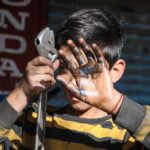
Debt bondage results when people are coerced to work against their will to repay a debt with an employer or recruiter, or when debt is manipulated to compel people to perform work tasks or accept work conditions that they would otherwise refuse. Such debts can last years or even generations. They can be manipulated in ways that make their settlement impossible.
The factors leading to debt bondage vary. Sudden shocks, such as job loss, can oblige workers without savings or access to formal credit markets to turn to predatory lenders offering loans under conditions tantamount to debt bondage. Others, already indebted, can be forced to offer their labour or that of a family member to service their debts when they are unable to do so through other means. Still
others fall into debt bondage through exorbitant fees, withheld wages, and other coercive practices of predatory recruiters or employers. Migrants in particular are susceptible to having to take on large debts to pay exorbitant costs related to recruitment and migration to secure work in countries of destination. Rarer but persistent traditional forms of debt bondage include people born into debt
bondage through debts purportedly accumulated by their forebears. One-fifth of people in forced labour exploitation are in situations of debt bondage. While the global estimates point to the occurrence of debt bondage across all sectors, its relative importance varies considerably from one to another. Debt bondage is most prominent in mining, agriculture, and construction, where 43 per cent, 31 per cent, and 27 per cent, respectively, of all forced labour cases involve debt bondage. Debt bondage is present in about one in five cases of forced labour in services and domestic work and in 14 per cent of forced labour cases in manufacturing. Other studies point to bonded labour in specific industries including brickmaking, tobacco, fishing, illegal logging and timber extraction, carpet weaving, and textile and garment manufacturing, among others. Marginalised communities, ethnic and religious minorities, and indigenous peoples are among the groups at particular risk.
from “Global Estimates of Modern Slavery
Forced Labour and Forced Marriage”
© International Labour Organization (ILO), Walk Free, and International
Organization for Migration (IOM) 2022





